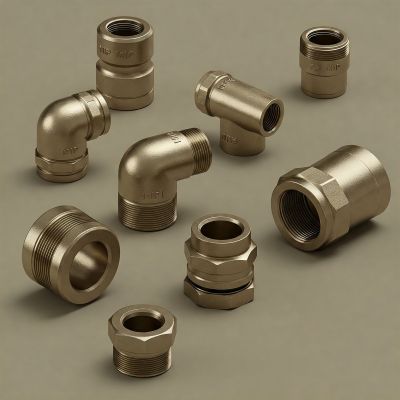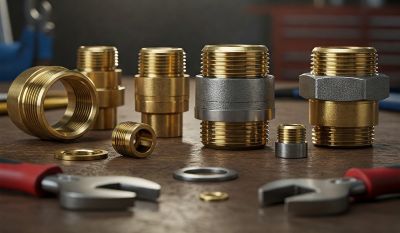Copper fittings play a crucial role in plumbing systems, providing strong and reliable connections for water, gas, and HVAC applications. Among the various types of threaded fittings available, MIP (Male Iron Pipe) and MNPT (Male National Pipe Thread) are two commonly used thread types. Understanding their differences is essential for proper installation and ensuring leak-free connections.
MIP and MNPT fittings may appear similar, but they have distinct characteristics that affect their compatibility and application. Choosing the wrong type can lead to improper connections, leaks, or fitting damage. This guide will break down the key differences between MIP and MNPT copper fittings, helping you make informed decisions for your plumbing projects.
Understanding MIP and MNPT Copper Fittings
What is MIP?
MIP, or Male Iron Pipe, refers to a type of threaded fitting used in plumbing systems. These fittings have external (male) threads designed to connect with Female Iron Pipe (FIP) fittings. MIP fittings are commonly made from copper, brass, or galvanized steel, offering durability and corrosion resistance.
Common Applications of MIP Fittings:
➡️ Water supply lines
➡️ Gas pipelines
➡️ HVAC systems
➡️ Industrial plumbing
MIP fittings are widely used in both residential and commercial plumbing applications due to their strength and reliability.
What is MNPT?
MNPT, or Male National Pipe Thread, is a specific type of thread standard established by the American National Standards Institute (ANSI). MNPT threads are tapered, meaning the diameter gradually decreases towards the end of the fitting, allowing for a tighter and more secure seal when connected to a corresponding female fitting.
Where MNPT Fittings Are Typically Used:
➡️ Gas lines
➡️ High-pressure plumbing applications
➡️ Compressed air systems
➡️ Water distribution networks
Because of their tapered design, MNPT fittings provide excellent sealing properties, reducing the risk of leaks in high-pressure environments.
Key Differences Between MIP and MNPT
This table provides a general overview. Always refer to the specific standards and manufacturer recommendations for the most accurate and up-to-date information.
|
Feature |
MIP (Male Iron Pipe) |
NPT (National Pipe Taper) |
|
Thread Profile |
Straight (parallel) |
Tapered (diameter decreases slightly along the thread length) |
|
Sealing Mechanism |
Primarily relies on thread engagement and sealants (like pipe dope) |
Primarily relies on the tapered design to create a tight seal as the threads are tightened |
|
Pressure Applications |
Generally suitable for moderate to high-pressure applications |
Well-suited for high-pressure applications |
|
Common Use Cases |
Widely used in plumbing, gas lines, and other industrial applications |
Frequently used in plumbing, gas lines, and other applications where a tight seal is critical |
|
Compatibility |
Compatible with female NPT threads |
Primarily designed to mate with female NPT threads |
1. Thread Design and Compatibility
One of the key differences between MIP and MNPT fittings is how their threads are cut. MIP fittings typically follow the National Pipe Thread (NPT) standard, making them functionally similar to MNPT fittings. However, in some cases, MIP threads may be straight rather than tapered, which can affect compatibility.
MNPT fittings always feature tapered threads, ensuring a tight seal when screwed into a corresponding female fitting. This design reduces the likelihood of leaks and enhances overall joint integrity.
2. Tapered vs. Straight Threads
➡️ MNPT Threads: Always tapered, meaning the diameter of the threads decreases along the length of the fitting, creating a tighter seal as it is screwed in.
➡️ MIP Threads: Can be either tapered or straight, depending on the manufacturer and application.
Tapered threads help prevent leaks by creating a mechanical seal as the fitting tightens. Straight threads, on the other hand, may require additional sealing materials, such as thread sealant or Teflon tape, to ensure a leak-proof connection.
3. Usage in Plumbing and Gas Systems
|
Feature |
MIP Fittings |
MNPT Fittings |
|
Thread Type |
Can be straight or tapered |
Always tapered |
|
Sealing Properties |
May require sealant |
Tighter seal due to taper |
|
Common Applications |
Water, gas, HVAC |
High-pressure gas, water, air systems |
|
Compatibility |
Connects with FIP |
Connects with FNPT |
MIP fittings are versatile and commonly used in standard plumbing, while MNPT fittings are more specialized for applications where high-pressure sealing is necessary.
4. Interchangeability
Can MIP and MNPT fittings be used interchangeably? The answer depends on whether the MIP fitting has tapered or straight threads.
➡️ Tapered MIP fittings can generally be used with MNPT fittings.
➡️ Straight-threaded MIP fittings may not provide a secure seal when paired with MNPT fittings and may require additional sealing measures.
Using thread sealant, such as Teflon tape or pipe dope, is recommended to ensure a leak-free connection when working with these fittings.
Choosing the Right Fitting for Your Application
When selecting between MIP and MNPT fittings, consider the following factors:
1. Compatibility with Existing Plumbing
Ensure that the fitting type matches the threads of the existing pipe or fitting. Mixing tapered and straight threads can lead to leaks or fitting damage.
2. Pressure Requirements
For high-pressure applications, MNPT fittings are often the better choice due to their superior sealing properties.
3. Sealing Needs
If using straight-threaded MIP fittings, apply thread sealant or Teflon tape to prevent leaks. MNPT fittings generally create a tighter seal on their own due to their tapered design.
4. Material and Corrosion Resistance
Consider the material of the fitting, especially for water and gas applications. Copper and brass fittings offer excellent corrosion resistance and durability.
5. Best Practices for Installation
➡️ Use the correct wrench: Over-tightening can damage the threads.
➡️ Apply thread sealant when necessary: Helps prevent leaks in certain connections.
➡️ Ensure proper alignment: Misaligned threads can lead to cross-threading and fitting failure.
Conclusion
Understanding the differences between MIP and MNPT copper fittings is essential for ensuring proper installation and a secure, leak-free plumbing system. While both fittings are commonly used in plumbing and gas applications, their thread designs and sealing properties set them apart.
Key Takeaways:
➡️ MIP fittings can have straight or tapered threads, whereas MNPT fittings are always tapered.
➡️ Tapered MNPT threads create a more secure seal, making them ideal for high-pressure applications.
➡️ MIP fittings are widely used in water, gas, and HVAC systems, while MNPT fittings excel in gas and high-pressure water lines.
➡️ Always check compatibility before installation and use thread sealant when needed to prevent leaks.
By selecting the right fitting type and following proper installation techniques, you can ensure the efficiency, safety, and longevity of your plumbing system. When in doubt, refer to manufacturer specifications or consult a plumbing professional for guidance.
Post time: Feb-19-2025



